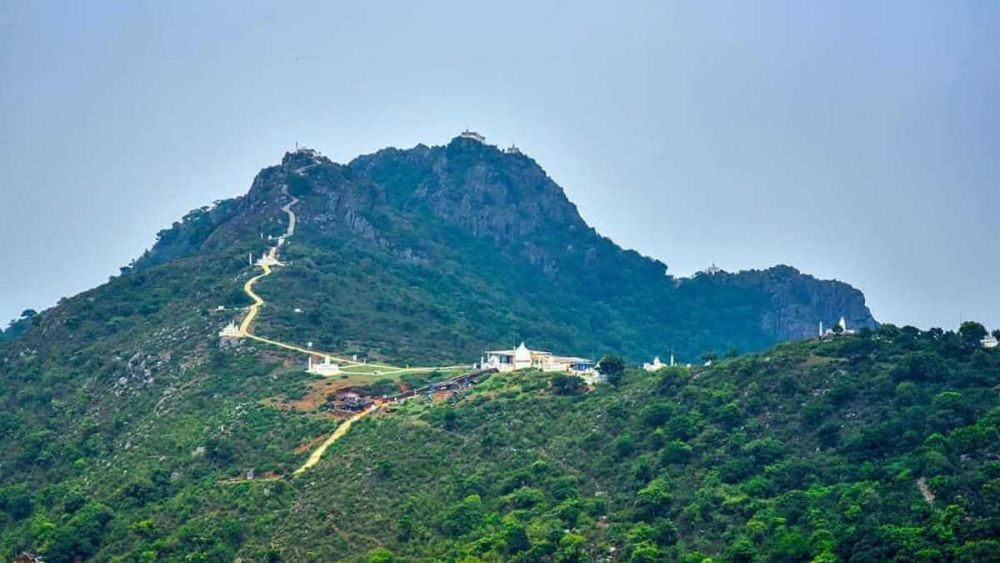December 8, 2025 10:34 pm
Religious Movements in Jharkhand – Jainism and Buddhism
Jharkhand, historically rich in tribal and cultural heritage, has also been significantly influenced by various Religious Movements in Jharkhand, particularly Jainism and Buddhism. These religions left a profound impact on the region, shaping its culture, art, and religious practices. Below is a detailed exploration of the influence of Jainism and some important sites associated with these movements in Jharkhand.
Influence of Jainism
Jainism holds a notable place in Jharkhand’s religious history, with Parasnath Hill being one of the most revered pilgrimage sites for Jains. Jainism’s influence in Jharkhand can be traced back to the early centuries BCE, where it is believed that several Jain Tirthankaras attained Nirvana in this region.
Parasnath Hill (1,365 meters / 4,478 feet)
- Location: Parasnath Hill, located in the Giridih district, is considered one of the holiest sites for Jains and is named after Lord Parshvanatha, the 23rd Tirthankara.
- Historical Significance:
- According to Jain scriptures, Lord Parshvanatha attained Nirvana on this hill around 717 BCE.
- This hill is renowned because 20 out of the 24 Jain Tirthankaras (spiritual teachers in Jainism) are believed to have attained Nirvana here.
- The hill is often referred to as the “Mecca of Jainism” due to its religious importance and the frequent pilgrimages made by Jain devotees from all over the world.

Tirthankaras Associated with Parasnath Hill
The following Jain Tirthankaras attained Nirvana on Parasnath Hill, cementing its status as a major religious site:
- Ajitnath – Second Tirthankara
- Sambhavnath – Third Tirthankara
- Abhinandan Nath – Fourth Tirthankara
- Sumatinath – Fifth Tirthankara
- Padmaprabhu – Sixth Tirthankara
- Suparshvanath – Seventh Tirthankara
- Chandraprabhu – Eighth Tirthankara
- Suvidhinath – Ninth Tirthankara
- Shitalnath – Tenth Tirthankara
- Shreyansnath – Eleventh Tirthankara
- Vasupujya – Twelfth Tirthankara
- Vimalnath – Thirteenth Tirthankara
- Anantnath – Fourteenth Tirthankara
- Dharmanath – Fifteenth Tirthankara
- Shantinath – Sixteenth Tirthankara
- Kunthunath – Seventeenth Tirthankara
- Aranath – Eighteenth Tirthankara
- Mallinath – Nineteenth Tirthankara
- Munisuvratnath – Twentieth Tirthankara
- Parshvanatha – Twenty-third Tirthankara and namesake of Parasnath Hill
- Pilgrimage and Cultural Importance:
- This hill is a major pilgrimage site for Jain followers, who view it as a place of immense spiritual power and sanctity.
- The site includes numerous ancient temples dedicated to the Tirthankaras, and it is a center for religious festivities and rituals.
- Due to its high spiritual value, Parasnath Hill is also referred to as the “Shikharji” in Jainism, translating to “the venerable peak.”
Other Significant Jain Sites and Cultural Influence in Jharkhand
- Chotanagpur Region (Modern-Day Dhanbad)
- Cultural and Literary Center: Historically, the Chotanagpur plateau was a hub of Jain culture and literature. The region fostered the growth of Jain religious practices and artistic expressions.
- Prominent Figures and Works: Jain monks and scholars frequented this area, contributing to its development as a center of knowledge and spirituality.
- Damodar and Kasai River Valleys
- Archaeological Remains: The valleys of the Damodar and Kasai rivers hold numerous remains linked to Jainism, including ancient statues, inscriptions, and artifacts.
- Symbolic Importance: These valleys were part of the routes taken by Jain monks and traders, and the artifacts found here reflect the religious harmony and multi-cultural exchanges in the area.
- Hanumand Village (Palamu District)
- Ancient Jain Sculptures: Hanumand village in Palamu is another significant site for Jainism. Archaeologists have discovered ancient Jain sculptures and other relics, showing that the village was once an important religious center.
- Preserved Artifacts: The sculptures found in Humaj are crucial to understanding the early spread of Jainism in Jharkhand and indicate the presence of a thriving Jain community.
- Bawanadih and Banashree (Singhbhum)
- Jain and Buddhist Remains: Sites like Bawanadih and Banashree contain stone slabs, stone tools, and ring stones associated with Jainism. These findings showcase the influence of both Jainism and Buddhism in the region.
- Cultural Convergence: These areas were likely shared by Jain and Buddhist communities, highlighting a period of religious tolerance and cultural blending.
Jain Scriptures and Terminology in Jharkhand
- Loh-Ayagada: In Jain texts, Lord Mahavira’s journey includes a reference to “Loh-Ayagada,” where “Ayagada” means iron, indicating a place with abundant iron resources, potentially aligning with Jharkhand’s rich mineral reserves.
- Parasnath Hill: Known in Jain literature as a sacred place where many Tirthankaras attained liberation. This name and the reverence associated with it point to the religious and spiritual significance of the area.
Jain and Buddhist Sites in Jharkhand
Jain Sites
- Singhbhum Region
- Benisagar:
- Contains Jain sculptures from the 7th century.
- Local Beliefs: Early residents of Singhbhum believed in Jainism, referring to it as “Sarak” Jainism. This Jain community was eventually moved out by the local Ho tribe.
- Benisagar:
- Kolkeshwari Hill (Located in Chatra District)
- Considered a sacred site with connections to Jainism.
- Houses several Jain temples and artifacts.
- Locally, it is also considered sacred by other tribal groups who see it as an embodiment of divine power.
Buddhist Sites
- Murtiya Village (Palamu District)
- This village houses a statue that represents Lord Buddha in a meditative seated posture with a lion throne.
- Kasmar Village
- Contains relics of Buddhist significance, including ancient statues and artifacts.
- Surajkund (Hazaribagh District)
- Known for hot springs and significant Buddhist statues found in this area.
- Belwatika (Deoghar District)
- An important site with Buddhist remains.
- Katumba Village (Hazaribagh District)
- Features relics linked to Buddhist practices, emphasizing its importance as a Buddhist center.
- Patna Cave (Near Ranchi)
- Houses ancient Buddhist relics and sculptures.
- Diuriya-Kala Village (Located in Deoghar District)
- Contains ancient Buddhist sculptures and artifacts.
- There is a well-known stupa constructed in traditional Buddhist architectural style, symbolizing the Buddhist influence in Jharkhand.
Other Notable Buddhist Sites
- Gholmara
- Located in a region where a broken stone Buddha statue was discovered, indicating the presence of Buddhist influences.
- Ichagarh (Saraikela-Kharsawan District)
- Famous for the Tara statue, which is dedicated to a Buddhist goddess. The statue is preserved in the Ranchi Museum.
- Sitagarh Hill (Hazaribagh District)
- Important Buddhist vihara established by followers of Buddhism.
- Also features a stupa, marking it as a site of religious importance.
Additional Historical Notes
- During the rule of the Pala dynasty in Bengal, Jharkhand saw the growth of Buddhism, particularly the Vajrayana sect.
- Jharkhand also has ancient sites such as the Kumar Gupta caves, which provide evidence of the influence of Buddhism in the region.
This detailed list of Jain and Buddhist sites in Jharkhand highlights the state’s historical and religious significance, with Jainism and Buddhism having deep roots through sacred sites, temples, and relics scattered across the region. These sites not only reflect the rich cultural heritage of Jharkhand but also serve as pilgrimage destinations for followers of Jainism and Buddhism.
JPSC Notes: Access expertly curated notes covering essential topics for both JPSC Prelims and Mains exams.
14th JPSC PT Exam Comprehensive Test Series: Enhance your preparation with a structured test series designed to cover all aspects of the JPSC Preliminary Test syllabus, emphasizing Jharkhand-specific topics and current affairs.
JPSC Notification 2024: Stay informed about the latest updates, including exam dates, eligibility criteria, and vacancy details for the JPSC 2024 examination.
General Introduction to Jharkhand for JPSC Exam: Gain a comprehensive understanding of Jharkhand’s history, geography, economy, and culture, crucial for the JPSC exam.
official Website: https://www.jpsc.gov.in/





